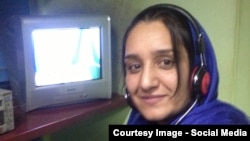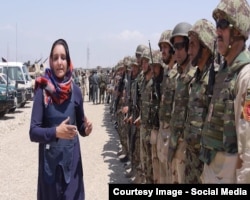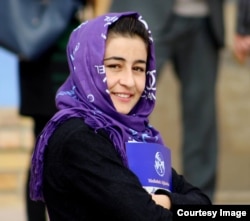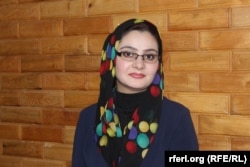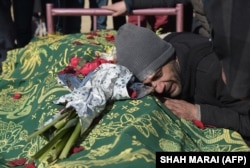Afghan and international leaders often celebrate Afghanistan’s relatively free press as one of the major achievements after the demise of the hard-line Taliban regime 16 years ago.
In recent year, ,however, violence, threats, harassment, taboos and uncertainty has forced some 100 Afghan women journalists to abandon the profession with some even fleeing the country.
Shakeela Ibrahimkhel became a star during her 10 year reporting career with one of Afghanistan’s leading news channel, Tolo TV. But in April 2016 she abruptly ended her career and made a horrendous illegal journey across Iran, Turkey, Greece and other European nations to claim asylum in Germany.
“I and my colleagues were threatened several times, we did not take it seriously. But they [the Taliban] attacked a bus carrying our colleagues [in January 2016],” Ibrahimkhel told Radio Free Afghanistan. “That attack was too painful for us.”
The attack, by a Taliban suicide bomber, killed seven Tolo employees while they were being driven to their homes from work on the evening of January 20 last year.
Ibrahimkhel became her family’s breadwinner after losing her husband to unknown assassins during Taliban’s draconian stint in power in the 1990s. She, her two sons and a daughter are now awaiting a decision on their asylum application near Frankfurt.
“I really loved my profession but the situation was getting worse, so I decided to leave my country, my family and my friends against my wishes,” she said.
Najib Sharifi, the head of Afghan Journalists Safety Committee (AJSC), a Kabul-based monitoring organization, says threats against journalists, women in particular, have mounted in recent years.
Security in Afghanistan has deteriorated substantially since the December 2014 departure of most NATO troops after the end of alliance’s major combat operations. During the past two years the Taliban have overrun large swathes of the countryside and are attempted to project power into the cities.
“Threats against media increased in 2015, particularly following the Taliban insurgents’ statement in which Tolo TV and 1TV were threatened, and I witnessed that a woman left her job after the threats,” he said. “But when Tolo TV employees came under attack, many women quit their jobs.”
He estimates that more than 100 women journalists and media workers have stopped working in the Afghan media organizations since 2014 due to increasing insecurity.
“Some of them fled the country,” he said without elaborating on where they might have gone.
According to AJSC, some 500 women journalists are currently working across Afghanistan. But growing insecurity are forcing many to abandon their profession.
Mahnaz Mawzoon, 25, is a journalist in Mazar-e Sharif, capital of Afghanistan’s northern Balkh province. She has seen her freedom of movement shrink considerably in recent years.
“Because of increasing insecurity, we cannot go to many districts for reporting,” she said. “We cannot file reports from remote regions.”
Yet Mawzoon has little choice. "Even if I get hurt or receive death threats, I still cannot quit my job [because I need it for making a living],” she stressed.
Twenty-three-year-old Nadia Zahel works as a presenter for a private TV channel in Kabul. She says that the overall environment for women journalists is frightening.
"I am afraid of the environment [I work in] and it is a threat to me,” she said. “I once decided to leave my job, because of the bad security situation.”
Nadia, who started working for the Afghan media seven years ago, says she expects that someday she will not be allowed to go on TV or even go out unaccompanied.
She told Radio Free Afghanistan that she has repeatedly faced harassment on the streets of Kabul because people recognize her from TV.
“I have decided not to go unaccompanied to the office, because people want to harm female TV presenters,” she said.
Nadia says some Afghan officials harass and make illegal and immoral demands from women journalists.
“This issue exists in every government and private institutions,” she claimed.
In the western Afghan province of Herat, women journalists have similar stories.
“Some people think that women who do reporting in the field do not observe morality and engage in illegitimate relationships,” Sumaya Walizada, a young woman journalist in Herat said.
She says some families are turning against allowing women as journalists because they fear this profession exposes their loved ones to dangers.
Sharifi, the head of AJSC, says in some rural provinces such as Paktika, Logar, Nuristan, Kunar, and Laghman there are no female journalists. AJSC says patriarchal traditions prevent women journalists form working in Paktia, Wardak, Ghazni, Kandahar, Helmand, Uruzgan and Zabul provinces.
“The lack of women journalists in these provinces is shameful,” Sharifi said.
Maria, 34, who works for Radio Moska in Lashkar Gah, the capital of volatile southern Helmand province, says women journalists feel pressured by some officials to self-censor.
"They often want us to avoid sensitive issues,” she said. “Sometimes an interviewee tries to delete an interview to prevent it from being disseminated.”
AJSC’s study on the conditions for Afghan women journalists titled “The Reporting Heroes” shows that female media workers faced mounting challenges.
“Female journalists in Afghanistan need to persuade their families, close relatives and, in some instances, tribes [and communities], to grant them permission to work outside the house,” the April 2016 report noted.
Afghan media laws consider censorship by powerful individuals as illegal. Saber Mohmand, a spokesman for the Ministry of Information and Culture, says the government is working to improve the working conditions for female journalists and have created a committee to protect journalists.
“The Afghan president recently issued a decree for the establishment of a committee for journalist safety under the leadership of the second vice president,” Mohmand said. “The deputy minister of information and culture is the member of the committee which operates in all 34 provinces,” he added.
He says that Afghan journalists are welcome to report cases of threats and intimidation to the government.
Still Afghanistan remains one of the deadliest countries for journalists, particularly women.
NAI, an independent media watchdog in Afghanistan, says there have been more than 14 fatal attacks against reporters and other media workers since the beginning of last year.
During this period NAI documented more than 415 cases of violence. These include murders, harassment, short-term detentions, and torture. It attributed 326 of these cases to the Taliban and the rest to the Afghan government.
According to global press freedom watchdog Reporters Without Borders, 2016 has been one of the deadliest for journalists in Afghanistan.
“Three of the ten journalists and media workers killed in 2016 were women,” the organization noted on its website. “Thirteen women journalists and media workers (including five foreigners) have been killed since 2001, and at least ten have had to flee the country.”
In May 2005, Shaima Rezayee, the presenter of a music show on Tolo TV was shot dead in Kabul. Two years later, Shekiba Sanga Amaj a Shamshad TV presenter, was shot in her home in Kabul.
Similarly, Zakia Zaki, a journalist and presenter for Radio Peace, was killed in northern Parwan province in 2007. Palwasha Tokhi, who worked as a journalist for Radio Bayan-e-Shamal, was attacked with a knife in her house in the city of Mazar-e Sharif capital of Balkh in September 16, 2014.
Michelle Lang, 34, who was working for the CanWest News Service, was killed in a roadside bomb attack in Kandahar province in December 2009. An Afghan police officer shot dead award-winning German news photographer Anja Niedringhaus and seriously wounded her Canadian colleague Kathy Gannon in the southeastern Khost Province in April 2014.
The attack took place one day ahead of presidential and legislative elections that Taliban militants had vowed to disrupt.
The situation worsened dramatically in 2015 after Taliban declared Tolo TV and 1TV legitimate “military targets” because of their alleged "disrespectful and hostile actions" against the militant group.
"No employee, anchor, office, news team, and reporter of these TV channels will be immune," a Taliban statement on October 12, 2015 said. "All the reporters and associates of these channels will be deemed enemy personnel, all of their centers, offices and field teams will be considered military targets, which will be eliminated."
Less than four months after the Taliban statement, a suicide attacker targeted employees of Tolo TV in Kabul on January 20, 2016.
During evening rush hour a suicide bomber drove an explosives-laden car into a minibus carrying the Afghan network’s employees. The blast killed its seven Tolo employees including three female workers, Mehry Azizi, Zainab Merzaie, and Maryam Ibrahimi.



